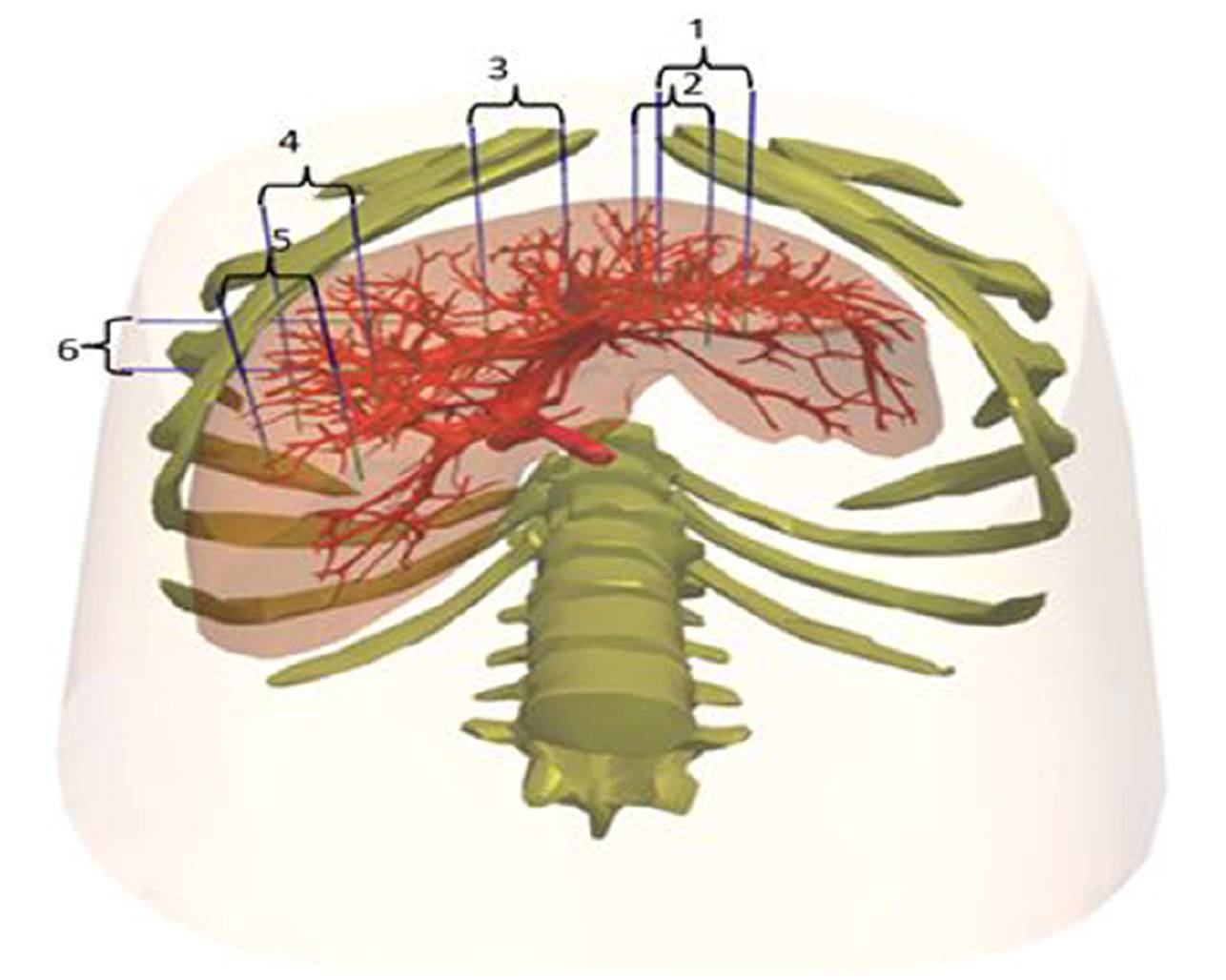A 3D model of the liver assesses the effectiveness of tumour ablation via irreversible electroporation
A 3D model of the liver assesses the effectiveness of tumour ablation via irreversible electroporation
A 3D model of the liver assesses the effectiveness of tumour ablation via irreversible electroporation
A study led by Radwan Qasrawi, PhD student of the Biomedical Electronic Research Group (BERG), has used this human liver model, which includes a thorough representation of the hepatic vascular network, to test a technique of ablation that presents certain advantages over previous ones.
Ablation by radio frequency or by means of microwave currents is the indicated treatment in some cases of liver tumours. Typically it is done by inserting an electrode through the skin that reaches the target tissue inside the liver. Ablation, i.e., the destruction of tissues, is achieved thanks to the heating caused by the microwaves or by the circulation of currents. One of the disadvantages of this type of treatment is the possibility of affecting other structures close to the tumour, such as blood vessels, bile ducts, etc. Hence, recently, alternatives have been sought such as irreversible electroporation (IRE), a relatively new kind of non-thermal ablation that has provided good results in clinical trials.
 IRE is carried out by inserting thin electrodes in the target tissue. These electrodes release a certain number (8-100) of high voltage short duration (10-100 μs) electrical pulses that cause electric fields in the order of 1000 V/cm in the tissue. This makes the cell membranes highly permeable to ions and macromolecules, which interrupts homeostasis, or cell equilibrium, with the consequent destruction of the tissue subjected to the treatment.
IRE is carried out by inserting thin electrodes in the target tissue. These electrodes release a certain number (8-100) of high voltage short duration (10-100 μs) electrical pulses that cause electric fields in the order of 1000 V/cm in the tissue. This makes the cell membranes highly permeable to ions and macromolecules, which interrupts homeostasis, or cell equilibrium, with the consequent destruction of the tissue subjected to the treatment.
This technique allows treating tissues close to blood vessels without any danger of affecting them. In view of this feature you might conclude erroneously that the presence of blood vessels is irrelevant for IRE ablation. A study published in the journal Technology in Cancer Research & Treatment has addressed this and has numerically analysed the potential impact of vessels in the ablation by irreversible electroporation of a tumour and it has served to illustrate that the blood vessels can indeed significantly affect the efficacy of the treatment.
The study was directed by Antoni Ivorra, coordinator of the Biomedical Electronic Research Group (BERG) of the Department of Information and Communication Technologies (DTIC) at UPF, with the participation of Radwan Qasrawi, PhD student with the BERG. Researchers from Hospital del Mar Research Medical Institute (IMIM), a UPF-affiliated centre, in conjunction with researchers from the University of Lyon (France) and the Al-Quds University in Palestine have also take part.
![Figure 3. Three-dimensional (3-D) volume plot of vessels (red), homogenous treatment region (green), tumor region (gray, only in B) and untreated spots (blue). A, Deep treatment of liver (no tumor) close to the right hepatic vein and the portal vein with 25-mm electrode active length and spacing, 3000 V applied potential. B, Tumor case study close to vessels with 15 mm active length, 14 mm spacing, and 2000 V applied potential (case 2 dimensional [2-D] illustrated in Figure 2C).](/documents/10193/7198695/ivorramodeledfig3.jpg/4af008c5-b0d7-29eb-00db-894bb0d447a8?t=1485859914071) In this research the researchers used an anatomically realistic computational model of the liver and its vascular network, in an abdominal section in which blood vessels down to 0.4 mm in diameter were considered. This means that on this same model, the researchers simulated a large series of possible scenarios (N=576) corresponding to plausible irreversible electroporation treatments by needle electrode pairs.
In this research the researchers used an anatomically realistic computational model of the liver and its vascular network, in an abdominal section in which blood vessels down to 0.4 mm in diameter were considered. This means that on this same model, the researchers simulated a large series of possible scenarios (N=576) corresponding to plausible irreversible electroporation treatments by needle electrode pairs.
The authors of the study have managed to conclude that current procedures for hepatic ablation by irreversible electroporation can leave small volumes of tissue untreated around the blood vessels in the area for treatment, and propose solving this problem with the infusion into the hepatic vascular network of isotonic low conductivity liquids.
Figure 1: 3D geometric representation of the six tested insertion points for the pairs of electrodes (in this case the space between the electrodes is 25 mm and the length of the electrode is 25 mm).
Figure 2: 3D volume graphic of the vessels (red), homogeneous treatment region (green), tumour region (grey, only in B) and untreated locations (blue). a) deep treatment of the liver (no tumour) near the right hepatic vein and portal vein with 25 mm active electrode with 25 mm separation and 3000 V applied potential. b) the tumour under near the vessels, 15 mm electrodes, 14 mm apart and with an applied potential of 2000 V.
Reference work:
Radwan Qasrawi, Louis Silve, Fernando Burdío, Ziad Abdeen, Antoni Ivorra (2017), “Anatomically Realistic Simulations of Liver Ablation by Irreversible Electroporation: Impact of Blood Vessels on Ablation Volumes and Undertreatment”, Technology in Cancer Research & Treatment, 17 January.
